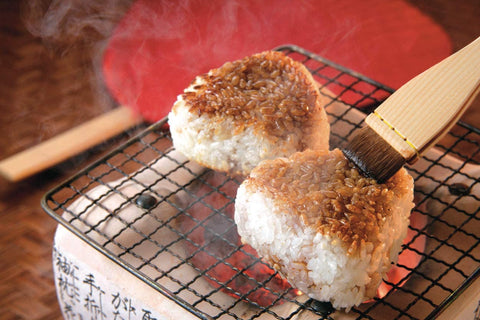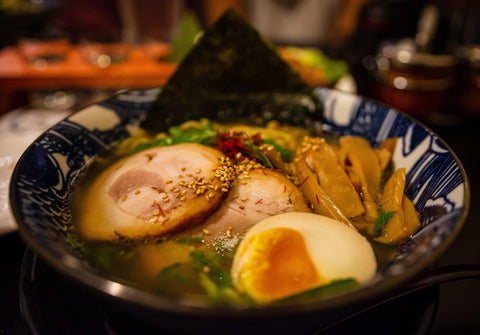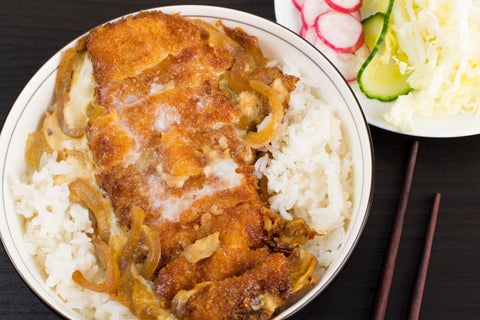
Jump to:
From onigiri to okonomiyaki, if you are a fan of Japanese food read on to discover 10 easy Japanese dishes you can try at home.
Making authentic Japanese dishes has never been easier thanks to excellent Japanese food bloggers who provide free step by step instructions to make all your favorite dishes, and you can order the exact ingredients you need directly from Japanese Taste who will ship them directly from Japan to your door!
In this article we’ll introduce the following recipes you can try alongside recommended ingredients you can purchase from Japanese Taste to make your dishes more authentic:
- Okonomiyaki recipe by Just One Cookbook
- Souffle pancakes by Ochikeron
- Japanese curry recipe by Pickled Plum
- Conbini onigiri recipe by Sudachi Recipes
- Omurice recipe by Chopstick Chronicles
- Japanese cheesecake recipe by RecipeTin Japan
- Sukiyaki recipe by Japanese-food.org
- Ramen recipe by Japanese Cooking 101
- Katsudon recipe by Hiroko’s Recipes
- Miso soup recipe by Princess Bamboo
Simple Okonomiyaki Recipe by Just One Cookbook
One of the best and most extensive Japanese cooking websites is Just One Cookbook, featuring more than 800 recipes for Japanese dishes created by chef Nami, broken down into easy-to-follow steps with photos and YouTube videos. It’s impossible to pick just one recipe to try, but if we had to choose, then okonomiyaki is a good dish to start with!
Okonomiyaki is a popular Japanese street food dish that originated in the Kansai region and is usually described as a savory pancake made from flour, eggs, and shredded cabbage. From there you can add whatever fillings you like, such as meat, seafood, cheese, and vegetables. Okonomiyaki is usally topped with okonomiyaki sauce, mayonnaise, dried bonito flakes, and aonori seaweed.

If you ever visit Japan, you’ll probably encounter two versions of okonomiyaki, Kansai-style, and Hiroshima-style. Whilst there is much debate as to which version is ‘better’, the difference between the two is that Hiroshima-style okonomiyaki also features a layer of noodles on top.
According to the Just One Cookbook recipe, to make okonomiyaki you’ll need the following specialist key ingredients: nagaimo (long yam) or silken tofu, tenkasu (tempura bits), okonomiyaki sauce, Japanese mayo, dried bonito flakes, and aonori seaweed.
If you want to save time or have trouble finding any of the ingredients for the batter, you can also buy ready made okonomiyaki flour with yam, and okonomiyaki kits. We also recommend investing in a stainless steel turner which will make the cooking process a lot easier!
Japanese Pancake Recipe by Ochikeron
Ochikeron is a popular Japanese YouTuber who started sharing her cooking videos and recipes in 2011 after the Great East Japan Earthquake. Today she has almost one million subscribers and in addition to her YouTube videos you can find the written recipes on her blog. Among the hundreds of dishes she has created, this recipe for Japanese souffle pancakes is one of our favorites. This simple recipe contains just five ingredients and explains very clearly how to make a popular sweet dish that can be somewhat tricky to master.

Unlike American-style pancakes or French crepes, Japanese pancakes are thick, fluffy, and jiggly. Fuwa fuwa is the Japanese word that springs to mind when thinking of souffle pancakes, which translates to the word “fluffy” in this context. Making a perfect souffle pancake is a bit of an art form and can take a bit of practice to perfect as the eggs need to be separated and whipped to the right consistency.
To make Japanese pancakes you’ll need egg, milk, flour, baking powder, and granulated sugar. We recommend investing in a good quality frying pan like this one from Shimomura which will allow you to effortlessly create beautiful looking pancakes without the need for a spatula or turner. If you don’t have time to make the batter yourself, you can always cheat by buying this ready made pancake mix based on a recipe from the acclaimed Pastry Chef at the Hotel New Otani.
Easy Japanese Curry Recipe by Pickled Plum
Pickled Plum is a Japanese food blog created by half-Japanese, half-Canadian blogger Caroline and features over a thousand delicious easy-to-make recipes. This classic recipe for Japanese curry and rice is a perfect winter dish as it’s warm and filling.

Japanese curry is one of Japan’s most loved everyday foods and is as commonly eaten today as dishes like ramen noodles or nabe (hotpot). Unlike its Asian counterparts which tend to be much spicier in taste, Japanese curry is milder and sweeter, and has been tailored to better suit the Japanese palate.
To make this Japanese curry and rice recipe, you’ll need onions, carrots, potatoes, and beef. In addition to these staple ingredients, we recommend purchasing Japanese curry roux for an authentic taste and to save having to make the sauce from scratch.
Easy Onigiri Recipe by Sudachi Recipes
Sudachi Recipes is a Japanese food blog created by Yuto, a food enthusiast from Okazaki in Aichi Prefecture. Among the traditional Japanese recipes he shares, we also love the inspiring Japanese dishes with a twist, like this recipe for Lawson Style “Devil’s Onigiri”, which is a recreation of a popular rice ball sold at the Lawson convenience stores throughout Japan.

Onigiri are Japanese rice balls that are usually triangular or circular in shape. Filling and easy to make, they are a popular Japanese food and can be found in every convenience store in Japan. Onigiri are made from white rice and are often wrapped in nori seaweed and can contain different fillings such as umeboshi, salmon, and tuna mayo.
This recipe for Lawson’s “Devil’s Onigiri” sees cooked rice mixed with tsuyu sauce, tempura bits, and aonori seaweed. We also recommend wrapping your onigiri in special onigiri plastic wrappers or sheets of nori seaweed for a professional look!
Omurice by Chopstick Chronicles
Chopstick Chronicles is a food blog created by Shihoko, a Japanese content creator living in Australia. Shihoko enjoys recreating her favorite Japanese recipes from home in Australia and sharing them through her blog, among which is this fantastic recipe for omurice.

Omurice is a comforting and filling dish that consists of an omelet made with fried rice, usually topped with ketchup, and a common dish found on the menus of most Japanese cafes. Although it may appear to be a simple dish to prepare, it’s trickier to perfect than it looks, as the egg is not supposed to have any hint of brown color on it.
For this version, which also includes chicken, we also recommend topping off your omurice with some Japanese Worcestershire sauce, or some authentic Japanese ketchup.
Easy Japanese Cheesecake Recipe by RecipeTin Japan
RecipeTin Japan features recipes by Yumiko, a Japanese food blogger based in Australia. She started her blog as a way of collating all her home cooking recipes for her family which has now grown into a website featuring hundreds of dishes! Yumiko’s Japanese cheesecake is one of the most popular recipes on her site.

Unlike traditional Western style cheesecake, Japanese cheesecakes are light and fluffy and are closer to a sponge cake than the kind of baked biscuit-based cheesecake that usually springs to mind. This delicious cheesecake is a popular Japanese dessert, and if it’s made correctly, should melt in the mouth, be light and moist, and not too sweet.
Make time in your day for an afternoon coffee break with a Japanese twist by enjoying this delicious cheesecake paired with some Japanese coffee or a cup of Royal Milk Tea!
Sukiyaki Recipe by Japanese-food.org
This sukiyaki recipe by Chika from the Japanese-food.org blog is a great example of some of the traditional and delicious Japanese dishes featured on her website. Chika is a Japanese citizen living in the US who shares her Japanese recipes that can be made using familiar ingredients from your local grocery store.

Sukiyaki is a dish served with marbled beef and is usually prepared in a cast iron pot. Thin slices of beef are simmered at the table along with ingredients such as tofu, long green onions, cabbage, and mushrooms, cooked together in a soy sauce broth.
This healthy recipe is gluten free and contains plenty of vegetables. To make the dish you’ll need some Japanese pantry essentials such as gluten-free soy sauce and cooking sake.
Ramen Recipe by Japanese Cooking 101
A good bowl of ramen noodles is so hard to find outside of Japan but this recipe from friends Noriko and Yuko who run the Japanese Cooking 101 blog makes it easy to create good ramen at home! Inspired by the food prepared by their mothers and grandmothers growing up in Japan, Noriko and Yuko specialize in sharing recipes for fresh, simple, Japanese meals that anyone can make at home.

Ramen noodles are made from wheat flour, water, salt, and a type of alkaline water called kansui, which is what gives the noodles their springy texture and yellow tint. Ramen dishes are often categorized according to their broth base, with the most popular kinds being shoyu (soy sauce), miso, and shio (salt).
For this ramen recipe we recommend using authentic Japanese soy sauce and serving your ramen with condiments you’d find in real ramen bars across Japan such as rayu seasoning (chili oil), mayu (garlic oil), and shichimi (seven spices).
You can also try using some of our delicious instant ramen noodles if you have trouble finding good quality noodles near you.
Katsudon Recipe by Hiroko’s Recipes
Hiroko’s Recipes is a Japanese food blog featuring home style family recipes by Hiroko, a Japanese born Australian. Hiroko’s katsudon recipe is so simple that anyone can follow it to create delicious Japanese comfort food.

Donburi are Japanese rice bowls with various toppings such as meat cutlets, tempura, or seafood. Katsudon is one of the most popular kinds of donburi which consists of a breaded pork cutlet cooked in egg and served over rice.
For this recipe, we recommend investing in a few authentic Japanese ingredients such as dashi stock, soy sauce, and mirin. Alternatively, if you are looking to save some time you can also purchase ready made donburi stock.
Miso Soup Recipes by Princess Bamboo
Princess Bamboo is a Japanese food blog created by foodie and cooking enthusiast Akino Ogata, who shares healthy Japanese recipes from vegetable dishes to soups. We particularly love this article called “Miso Soup in 5 Ways” as it gives readers five different varieties of miso soup that you can easily make at home, making this Japanese staple dish a lot more interesting!
The five recipes include instructions for how to make miso soup with pork and root vegetables, miso soup with potato and onion, miso soup with four kinds of mushroom, miso soup with Japanese greens and deep-fried tofu, and miso soup with egg and toasted sesame seeds.

You can mix up the ingredients for miso soup but there are a few essential items that you will need including dashi stock and miso paste. Miso soup will vary in taste according to the color paste that you use: red miso, white miso, or yellow miso. Red miso gives a more intense flavor, yellow is milder and sweeter than red miso, whilst white miso is the mildest and sweetest of the three.
We also recommend checking out the packs of Nagatanien Miso Soup ingredients filled with dried wakame, Japanese fu (wheat gluten), and spinach that you can add instantly to your soup.


0 comments